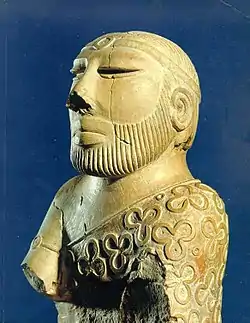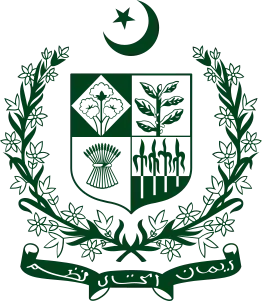Military coups in Pakistan
Military coups in Pakistan began in 1958[1] There have been numerous successful attempts since 1951. Since its creation in 1947, Pakistan has spent several decades under military rule (1958 – 1971, 1977 – 1988, 1999 – 2008).
Part of a series on the |
|---|
| History of Pakistan |
 |
| Timeline |
|
1953/54 constitutional coup
In 1953, the Governor-General Ghulam Muhammad dismissed the government of the Prime Minister Khawaja Nazimuddin despite it enjoying the support of the Constituent Assembly of Pakistan; then in 1954 he dismissed the Constituent Assembly itself to prevent it changing the constitution to restrict the Governor-General's powers. In doing this he had the support of General Ayub Khan who provided troops to control communications with London so as to avoid any possibility of the Queen being advised to replace the Governor-General. The failure of the courts to support representative institutions in Federation of Pakistan v. Maulvi Tamizuddin Khan provided a pattern which latter led to more open military intervention against elected governments to be justified using a doctrine of necessity.[2]
1958 coup
In 1958, the first Pakistani President Major General Iskander Mirza dismissed the Constituent Assembly of Pakistan and the government of Prime Minister Feroz Khan Noon, appointing army commander-in-chief Gen.[3] Ayub Khan as the Chief martial law administrator. Thirteen days later, Mirza himself was exiled by Ayub Khan, who appointed himself president.[4]
1977 coup (Operation Fair Play)
Operation Fair Play was the code name for the coup d'etat conducted at midnight on July 4, 1977 by the Pakistan military, led by Chief of Army Staff General Zia-ul-Haq, against the government of then-Prime Minister Zulfikar Ali Bhutto. General Zia ordered the arrest of Bhutto, his ministers and other leaders of both the Pakistan People's Party and the Pakistan National Alliance.[5] In a nationally televised address, General Zia announced that the National Assembly of Pakistan and all provincial assemblies were dissolved, and that the Constitution of Pakistan was suspended.[6]
The martial law enforced by President General Zia, it introduced the strict but modern form of conservatism which promoted the nationalistic and religious programmes.[7]
1999 coup
In October, 1999 senior officers loyal to army chief Gen. Pervez Musharraf arrested prime minister Nawaz Sharif and his ministers after thwarting the Sharif regime's attempt to dismiss Musharraf and prevent his plane from landing in Pakistan as he returned from a visit to Sri Lanka.[8]
Indirect intervention
The death of Zia-ul-Haq led to the appointment of Ghulam Ishaq Khan as President. Khan had vast, unchecked Presidential powers and was known to be close to the Pakistani military. Khan had dismissed both Benazir Bhutto in 1990 and Nawaz Sharif as Prime Minister in 1993, though the latter resulted in his own resignation and is known in Pakistan as the Waheed Kakar formula.
Unsuccessful coup attempts
There have been numerous unsuccessful coup attempts in Pakistani history. The first noted attempt was the Rawalpindi conspiracy in 1951 led by Maj. Gen. Akbar Khan along with left-wing activists and sympathetic officers against the government of Liaquat Ali Khan, Pakistan's first prime minister.[4] Prominent poet-intellectual Faiz Ahmed Faiz was suspected of involvement.[9] In 1980, a plot by Maj. Gen. Tajammul Hussain Malik to assassinate Zia-ul-Haq on Pakistan Day on March 23, 1980 was exposed and thwarted.[10][11]
In 1995, a coup attempt against the government of Benazir Bhutto led by Maj. Gen. Zahirul Islam Abbasi with the support of Islamic extremists was foiled. An alleged coup attempt planned by Mustafa Khar during his exile during General Zia ul Haq's reign was thwarted beforehand due to Seth Abid playing double agent and informing the military about the plot. Allegedly, some disgruntled army officers were provided details of a safe house where weapons procured from India directly by Mustafa Khar after negotiating with an Indian agent in their London High Commission. This has been discussed in great length and detail by Tehmina Durrani in her award-winning book 'My Feudal Lord' where she admits to playing a passive role under duress of her then husband Mustafa Khar.
See also
References
- "The curse that no Pakistan ruler has ever escaped".
- Pakistan - Constitutional Beginnings, Country Data
- Butt, Daud (2020-10-24). "On the Same Page -The History of Martial Law in Pakistan". The Wallet. Retrieved 2020-10-25.
- Hassan Abbas (2005). Pakistan's drift into extremism: Allah, the army, and America's war on terror. M.E. Sharpe. pp. 16–40. ISBN 978-0-7656-1496-4.
- Hyman, Anthony; Ghayur, Muhammed; Kaushik, Naresh (1989). Pakistan, Zia and After--. New Delhi: Abhinav Publications. p. 30. ISBN 81-7017-253-5.
Operation Fair Play went ahead … as the clock struck midnight [on 4 July 1977] ... [Later,] General Zia [told Bhutto] that Bhutto along with other political leaders of both the ruling and opposition parties would be taken into what he called 'protective custody'.
- Dossani, Rafiq; Rowen, Henry S. (2005). Prospects for Peace in South Asia. Stanford University Press. p. 42. ISBN 978-0-8047-5085-1.
Zia-ul-Haq, however, chose not to abrogate the 1973 Constitution. Rather, Zia's government suspended the operation of the Constitution and governed directly, through the promulgation of martial law regulations … Between 1977 and 1981 Pakistan did not have legislative institutions.
- Cohen, Stephen P. (2004). The idea of Pakistan (1. paperback ed.). Washington, D.C.: Brookings Institution Press. ISBN 0815715021.
- "World: South Asia : Pakistan arm". BBC NEWS. 1999-10-12. Retrieved 2009-04-22.
- Muhammad Yusuf Abbasi (1992). Pakistani culture: a profile. National Institute of Historical and Cultural Research. ISBN 978-969-415-023-9.
- Tajammul Hussain Malik (1991). The Story Of My Struggle. Jang Publishers. pp. 220–280.
- World Focus, Volume 2. H.S. Chhabra. 1981.

